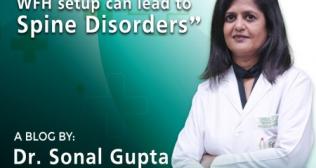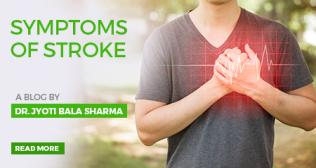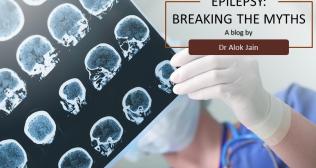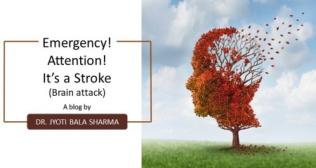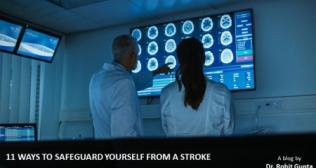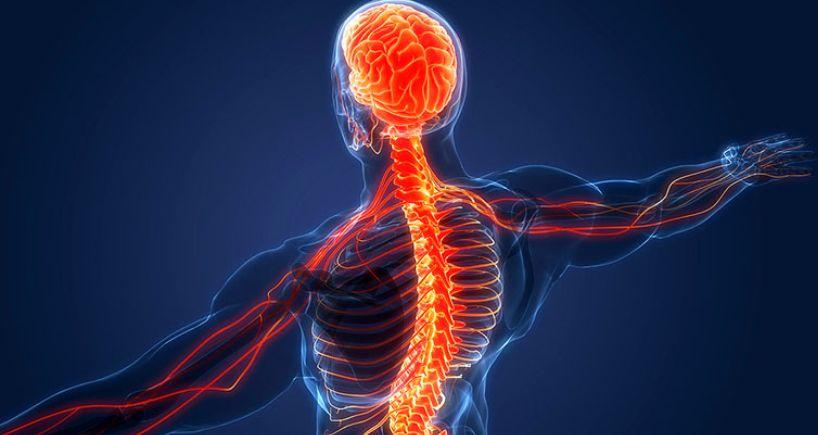
The Nervous System: An Introduction, Central Nervous System: Control Center of the Body
The important functions of the body and mind are carried out by the nervous system. It controls various activities, such as thinking and learning. It coordinates with the endocrine system to regulate the body's mechanisms.
Types of Nervous System
The nervous system is divided into two divisions based on structure, function, and characteristics. It includes - the central nervous system and peripheral nervous system. In the nervous system, bundles of nerve fibers constitute a nerve.
Central nervous system
The main components of the central nervous system are the brain and spinal cord. It is also called the control center of the body. These vital organs are covered by connective tissues called meninges. They are also protected by cerebrospinal fluid. The skull (cranium) protects the brain while the spinal cord is present in the vertebral column. Cranial nerves are the nerves arising from the brain while spinal nerves emerge from the spine.
Meninges
Meninges covers the brain in three layers. Dura mater, a white fibrous tissue is the strong outer layer. Arachnoid mater, the middle layer has thread-like structures that attach them to inner layer. Pia mater, the inner layer and arachnoid mater contains a space filled with blood vessels and cerebrospinal fluid (CSF). This fluid protects the brain from an external environment with its cushioning nature.
Brain
Cerebrum – The largest area of the brain is called the cerebrum. A fibrous structure called corpus callosum divides the cerebrum into two halves. The two halves communicate with each other with the help of the corpus callosum.
Diencephalon – The central portion of the brain is called diencephalon, which is surrounded by the cerebrum. The parts of the diencephalon include:
- Thalamus – The sensory signals reach the cerebral cortex through thalamus. Hence, it is referred to as a relay point.
- Hypothalamus – The basic functions of the body, such as temperature and thirst, are managed by the hypothalamus.
- Epithalamus – Sleep patterns are managed by epithalamus. It is also responsible for the onset of puberty.
Brain stem – The structure between the diencephalon and spinal cord is called as brain stem. The parts of the brain stem are:
- Midbrain – It is present in the upper portion of the brain stem.
- Pons – This structure transfers signals between the brain and spinal cord.
- Medulla Oblongata – The vital functions of the body, such as respiratory rate and heart rate, are controlled by medulla oblongata.
Cerebellum – This small structure is located below the cerebrum. It helps in coordinating various movements of the body and maintain the balance.
Spinal cord
Spinal cord is a long tubular structure. It begins from the base of the skull and runs to the lower back. It transfers sensory information from the body to the brain. It also acts as a reflex center and gives a quick response. For example, moving the hand away from hot vessels.
Peripheral nervous system
The peripheral nervous system is made up of nerves and ganglia. The brain and spinal cord are interconnected with the remaining body through the nerves. Ganglia contains numerous nerve cell bodies. It is usually present outside the brain and spinal cord.
There are two classifications in the peripheral nervous system - afferent (sensory) divisions and efferent (motor) divisions. As the name says, the sensory divisions transmit sensory information from peripheral organs such as muscles and glands to the central nervous system. The muscles and glands receive signals from the efferent divisions to create an action or effect.
There are two subdivisions in efferent (motor) divisions - somatic nervous systems and autonomic nervous systems.
- Somatic nervous system – The voluntary movements of the body are controlled by the somatic nervous system. For example, the movement of skeletal muscles. Hence, it is commonly called the voluntary nervous system.
- Autonomic nervous system – The automatic functions such as breathing, heartbeat, respiration, gland secretions are controlled by autonomic nervous system. These actions cannot be controlled by us and are called involuntary actions. There are two pathways in autonomic nervous system – sympathetic and parasympathetic pathways.
Types of nerves
Cranial nerves - The regions of the head, neck, and face are supplied by twelve pairs of cranial nerves. Three nerves have sensory fibers and carry out functions such as sight, smell, sound, and body balance. Five nerves supply muscles and are responsible for motor functions. However, four nerves have both sensory and motor fibers.
Spinal nerves – The spinal cord contains thirty-one pairs of spinal nerves. It arises from the sides of the spinal cord. These nerves consist of both sensory and motor components.
Structure of nerve
The nerve cells or neurons are the building blocks of the nervous system. Each human has approximately 100 billion neurons in their body. A neuron is comprised of a body, nucleus, and extensions called axons and dendrites. Bundles of axons are referred to as nerves. Each nerve cell transmits a signal to another through an axon.
Types of neurons
Various activities such as movements, sensations, memory, and communication are performed by different types of nerve cells. These nerve cells transmit signals from the brain to the particular organ for performing the activity. However, aging can deteriorate the functional ability of these nerve cells.
- Motor neurons – These neurons send signals from the brain to the muscles to perform movements such as chewing, shaking hands, walking and signals the glands to produce secretions. Muscles and glands are called effectors as they act to the response received from the nervous system.
- Sensory neurons - Various senses, such as touch, smell, and sight, are managed by sensory neurons.
- Interneurons – The communication between motor and sensory neurons is carried out by interneurons. It regulates the movement in response to sensory stimulation. For example, moving the hand away from the fire.
Nerve Impulses
Our body has receptors to detect changes from external factors such as temperature, sound, and internal factors such as pH level, carbon di oxide concentration, pressure, and electrolyte levels. These factors are referred to as stimuli. The brain receives information in the form of an electrical signal called nerve impulses.
Conclusion
The nervous system has a major role in our daily activities. It responds to stimuli and adapts to bodily changes. It helps in processing sensory information, cognitive functions such as memory and learning and communicates between different organs of the body.
Popular Searches :
Hospitals: Cancer Hospital in Delhi | Best Heart Hospital in Delhi | Hospital in Amritsar | Hospital in Ludhiana | Hospitals in Mohali | Hospital in Faridabad | Hospitals in Gurgaon | Best Hospital in Jaipur | Hospitals in Greater Noida | Hospitals in Noida | Best Kidney Hospital in Kolkata | Best Hospital in Kolkata | Hospitals in Rajajinagar Bangalore | Hospitals in Richmond Road Bangalore | Hospitals in Nagarbhavi Bangalore | Hospital in Kalyan West | Hospitals in Mulund | Best Hospital in India | | Cardiology Hospital in India | Best Cancer Hospital in India | Best Cardiology Hospital in India | Best Oncology Hospital In India | Best Cancer Hospital in Delhi | Best Liver Transplant Hospital in India
Doctors: Dr. Rana Patir | Dr. Rajesh Benny | Dr. Rahul Bhargava | Dr. Jayant Arora | Dr. Anoop Misra | Dr. Manu Tiwari | Dr. Praveer Agarwal | Dr. Arup Ratan Dutta | Dr. Meenakshi Ahuja | Dr. Anoop Jhurani | Dr. Shivaji Basu | Dr. Subhash Jangid | Dr. Atul Mathur | Dr. Gurinder Bedi | Dr. Monika Wadhawan | Dr. Debasis Datta | Dr. Shrinivas Narayan | Dr. Praveen Gupta | Dr. Nitin Jha | Dr. Raghu Nagaraj | Dr. Ashok Seth | Dr. Sandeep Vaishya | Dr. Atul Mishra | Dr. Z S Meharwal | Dr. Ajay Bhalla | Dr. Atul Kumar Mittal | Dr. Arvind Kumar Khurana | Dr. Narayan Hulse | Dr. Samir Parikh | Dr. Amit Javed | Dr. Narayan Banerjee | Dr. Bimlesh Dhar Pandey | Dr. Arghya Chattopadhyay | Dr. G.R. Vijay Kumar | Dr Ashok Gupta | Dr. Gourdas Choudhuri | Dr. Sushrut Singh | Dr. N.C. Krishnamani | Dr. Atampreet Singh | Dr. Vivek Jawali | Dr. Sanjeev Gulati | Dr. Amite Pankaj Aggarwal | Dr. Ajay Kaul | Dr. Sunita Varma | Dr. Manoj Kumar Goel | Dr. R Muralidharan | Dr. Sushmita Roychowdhury | Dr. T.S. MAHANT | Dr. UDIPTA RAY | Dr. Aparna Jaswal | Dr. Ravul Jindal | Dr. Savyasachi Saxena | Dr. Ajay Kumar Kriplani | Dr. Nitesh Rohatgi | Dr. Anupam Jindal |
Specialties: Heart Lung Transplant | Orthopedic | Cardiology Interventional | Obstetrics & Gynaecology | Onco Radiation | Neurosurgery | Interventional Cardiology | Gastroenterologist in Jaipur | Neuro Physician | Gynecologist in Kolkata | Best Neurologist in India | Liver Transfer









